[vc_row][vc_column][vc_column_text]
Leadgate Village
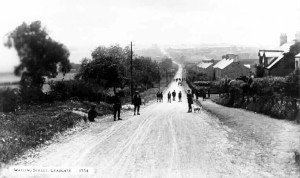
The Romans had obviously been to what became Leadgate when they constructed Dere Street and there had been coal mining in the area for many years before the village became established. But, before 1834, Leadgate (not including the hamlet of Redwell Hills) consisted of St. Cuthbert’s Chapel, (the precursor of the Brooms Church) half a dozen farms, East House and a few cottages.
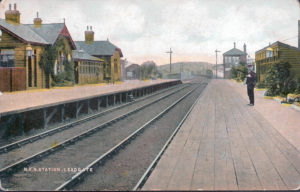
So that year, when the Stanhope and Tyne Railway came through the village, there were not many people to cheer the inaugural “train”.
For many years afterwards the children of Leadgate were led to believe that it was so named because lead carriers had to pay a toll at a gate near to the village crossroads.
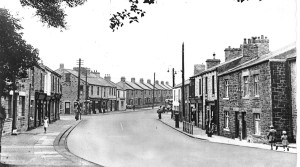
In fact, the name was probably derived from an earlier name Hlidgeat, meaning the gate to the common (or wilderness as some said).
Once the railway had helped the Derwent Iron Company to come into being, the Eden Shaft was sunk and the three (Bradley) blast furnaces were built at Leadgate.
The workers flocking into the area to man these enterprises needed housing and so the “Company” built approximately 500 cottages (in Squares) in the village. Associated private housing was constructed and
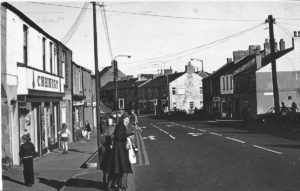
businesses to service the population were established mainly along Front Street. It was a population of mixed “descent” with men from Cornwall, Staffordshire, Wales, Ireland, Scotland and the Dales coming to work the mines and furnaces. (In its early days the ratio of male to female being amongst the highest in the realm.) For fifty or sixty years the diverse traditions, outlooks and religious faiths, which these incomers had brought, created tensions and rivalry that made the village a very “lively” place in which to live. However as families developed so did the need for churches, schools, medical provision, sporting and recreational facilities and “boards” to arrange “civic” necessities…
The oldest church serving Leadgate was the Roman Catholic chapel of St. Cuthbert, (now the Broom’s Sacristry), which was opened in 1802. By 1860s it was too small to serve a large parish and a rapidly growing congregation and
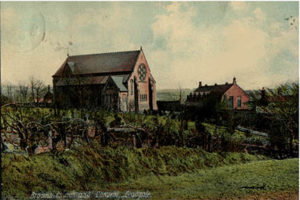
in 1869 the Church of Our Lady And St. Joseph was opened at the Brooms.
Meanwhile St. Ives Anglican Church was established in 1872 with an 1884 house of the Dunn family being adopted as the vicarage. ( Prior to this time there had been an Anglican Chapel of Ease in a building provided by the Derwent Iron Company on what became Church Square.)
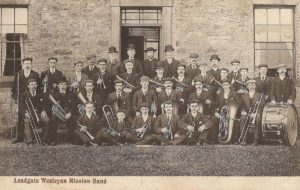
Somewhat earlier a Wesleyan Methodist Chapel was opened in Front Street in the late 1840s,
a Primitive Methodist Chapel in Watling St
in 1874, a free Methodist Chapel that became the Miners Hall in 1875
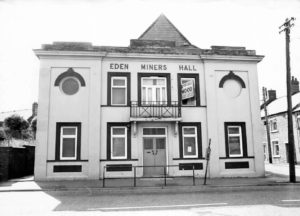
and the Salvation Army Citadel in 1923.
The first two schools in the village were provided by the Derwent Iron Company in 1856 one for girls at Church Square and one for boys at Bottle Bank, later to become a Wesleyan Day School. In 1863 a Catholic school was built on the opposite side of the railway to the Broom’s Church and in 1925 a Catholic Infants’ School in St. Ives Road. 1870 saw the “Hills” St. Ives Church School opened in a building originally utilised by the Roman Catholics. In 1908 following the closure of the Bottle Bank Site the Council Schools were opened in West Street.
Although the Iron Company provided the first “civic” infrastructure for Leadgate, with the parish overseeing highways and Poor Law administration, there was a need for elected self-government and in 1866 the Leadgate Local Board, (which provided Leadgate Park), first met. In 1895 it became Leadgate Urban District Council, in 1937 part of Consett Urban District Council and in 1973 part of Derwentside.
The first medical practitioner in the village, Dr George Renton, arrived in the early 1880s whilst the longest serving, Dr George Ewen, stayed here for 40 years.
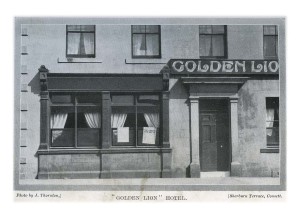
Leadgate Industrial and Provident Society’s first shop of 1870 was in a room of The Golden Lion.
Early principal football teams in the village were Leadgate Park and the Exiles the former having a largely Protestant following and the latter Catholic support, Needless to say in those days they were bitter rivals. The more gentle game of cricket was first played, by a Leadgate team, in a field at Bunker Hill Farm than in the Park before settling for the ground at Garden Place.
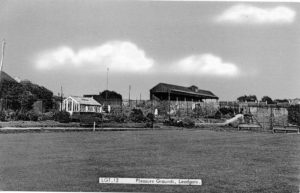
However, sporting/recreation provision really took off in the village when in 1929 the “Eden Miners Welfare” began to construct a park consisting of a bowling green, tennis courts and a children’s playground. This was combined with the upgrading of the football field and the construction of arguably one of the finest grandstands in the north of England.
Today the old “ethnic” tensions are far behind us and the village has a strong ecumenical ethos. Leadgate continues to evolve whilst retaining reminders of its earliest features. Some of the Squares, albeit changed, still remain. The Coast to Coast Cycle Track has replaced the railway lines and the coming down of the high railway walls and bridges tends to unite the village. There is still a Co-Op on Front Street. We have retained our Post Office and whilst our banks have gone we “have a hole in the wall” facility. The Boys Brigade and Church Lads Brigade may have disappeared but the Cubs and Scouts are going strong. The original football, cricket fields and bowling greens are much improved and still in regular use. Despite the demise of concert and drama groups, in the face of television and D.V.D’s the Leadgate Gleemen continued to sing till 2014. The Anglicans, Catholics and Salvation Army still worship in their original buildings whilst the Methodists are united in a “new” church in Tyne Avenue. Meanwhile, Leadgate has acquired a first-rate Medical Centre, a Pharmacy, a veterinary practice, a refurbished community centre, a nursing home, a residential home and a gymnasium. As poor employment substitutes for the Eden Pit and Bradley Engineering Shops, there are two industrial Estates but the village is going Green as Watling Wood continues to flourish in place of the old spoil heaps of the 1840’s blast furnaces.
Author,
Bill Stockdale.
June 2014
[fu-upload-form form_layout=’post_media’][/vc_column_text][/vc_column][/vc_row][vc_row][vc_column][/vc_column][/vc_row]
I was at leadgate Methodist church until I moved at age 14 to York. I remember the new building opening. I first heard about Jesus at your church and still continue to serve the Lord now
with best wishes
Ann